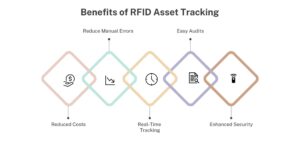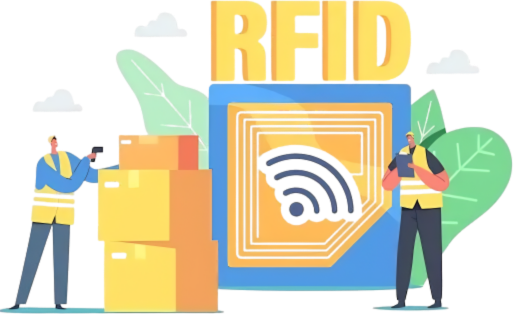Introduction
Asset tracking is the backbone of effective operations across industries—from IT and manufacturing to healthcare and retail. Traditionally, companies have relied on barcode systems or manual checks to monitor assets. However, these methods often fall short in terms of efficiency and reliability. RFID technology overcomes the limitations of barcode scanning by eliminating the need for a line‑of‑sight—without significant additional costs or implementation hassles. In this post, we will explore the key aspects of RFID asset tracking and explain how adopting this technology can revolutionize your asset management strategy.
What is RFID Asset Tracking?
RFID asset tracking employs radio frequency signals to automatically identify assets through small tags affixed to each item. These RFID tags store unique data that is captured by RFID readers. Unlike barcodes—which require manual scanning—RFID tags can be read remotely and simultaneously, significantly expediting physical verification and tracking processes. By automatically updating asset status and location in real time, RFID asset tracking enables organizations to maintain accurate records, streamline operations, and reduce the risk of lost or stolen assets
RFID vs. Traditional Barcode Systems
Although barcode systems have long been used for asset tracking, they require a direct line of sight and individual scanning of each item, making the process labor‑intensive and slow. In contrast, RFID technology uses radio waves to read multiple tags concurrently without a visual connection. Consequently, RFID provides much faster data collection and enhanced reliability, making it a popular choice for modern asset management.
Read Comparison of Barcode Vs. RFID Asset Tracking – Pros & Cons of Two widely used Technologies>>
Types of RFID Asset Tracking
RFID asset tracking systems are available in three primary types, each suited to different applications and budgets:
-
Passive RFID
Passive RFID tags are the most commonly used type. Unlike active tags, they lack an internal power source. Instead, they draw power from radio waves emitted by RFID readers. Therefore, they offer a cost-effective solution for many businesses. Specifically, they suit use cases where real-time location tracking is unnecessary. For instance, they help automate physical asset verification. Additionally, they support check-in and check-out monitoring with minimal infrastructure.
-
Active RFID
Active RFID tags come with an internal battery that enables them to transmit data continuously. These tags are designed for tracking high‑value or critical assets in real time over longer distances. Although they are more expensive than passive tags, their ability to provide continuous tracking and cover wider areas makes them essential when real‑time asset location is required.
-
Semi‑Passive RFID
Also known as battery‑assisted passive (BAP) RFID tags, these combine features of both active and passive tags. They include a battery to power certain functions but still rely on the RFID reader’s signal for communication. This hybrid solution offers improved performance over passive tags while keeping costs lower than those of fully active tags.
RFID Asset Tracking Applications
RFID technology is highly versatile, offering a range of applications across various industries:
-
Automation of Physical Asset Verification
Manual asset verification is time‑consuming and error‑prone. RFID systems automate this process by enabling the simultaneous scanning of multiple assets—even through barriers. For example, during periodic audits, an RFID reader can quickly confirm the presence of hundreds of assets, reducing verification time from hours to minutes.
Perform Fast and Accurate
Physical Verification – Every Time
AssetCues has helped transform asset verification and reconciliation
process for many Fortune 500 companies
Perform Fast and Accurate Physical Asset Verification - Every Time
AssetCues has helped transform asset verification and reconciliation processes for many Fortune 500 Companies.
-
IT Asset Tracking
Organizations managing large inventories of IT equipment—such as laptops, monitors, servers, and other mobile devices—benefit from RFID by tagging each asset with a unique identifier. This allows companies to monitor asset movement and usage in real time, ensuring that high‑value items are always accounted for and enhancing overall IT asset management.
-
Real‑Time Location Systems (RTLS) Using Active RFID
Active RFID tags are crucial for RTLS applications. These systems continuously track the location of assets in environments like hospitals, healthcare facilities, or large manufacturing plants. RTLS enables managers to monitor asset movement, quickly locate items, and optimize workflow efficiencies.
-
Tool Tracking
In industries where tools are frequently shared among employees—such as construction, manufacturing, or maintenance—RFID tracking minimizes loss, prevents unauthorized usage, and optimizes tool utilization.
-
RFID Medical Equipment Tracking
Healthcare facilities use RFID to track expensive and critical medical equipment. Automated tracking reduces downtime, improves patient care, and ensures compliance with regulatory standards.
Components of an RFID Asset Tracking System
Implementing an effective RFID asset tracking system requires understanding its key components:
-
RFID Asset Tracking Software
This software acts as the brain of the system and processes data collected by RFID readers. Additionally, it automates physical asset verification and maintains an up-to-date asset database. It also monitors asset movement and generates dashboards and reports. Moreover, a robust software solution integrates with existing enterprise systems. This way, it supports comprehensive and seamless asset monitoring.
-
RFID Asset Tags
RFID tags, affixed to each asset, consist of a microchip and an antenna. The microchip stores a unique identifier along with other pertinent data, while the antenna transmits this information to the RFID reader. When selecting tags, consider factors such as durability, cost, and the specific requirements of the asset—for example, tags for metal objects may require specialized designs due to potential interference.
-
RFID Hardware
This includes RFID readers and antennas.
Fixed Readers: Installed at strategic locations (e.g., doorways, loading docks) to capture asset movements and deter unauthorized transfers.
Mobile Readers: Handheld devices used for conducting physical audits or tracking assets across large areas.
The choice between fixed and mobile readers depends on your tracking needs and the operational environment.

White Paper
Automate recording of Asset check-in and checkout using RFID Technology. Download our latest white paper to learn how to implement and benefit from automation
White Paper
Discover how AssetCues automates asset verification and management in SAP, enhancing accuracy, efficiency, and compliance. Learn more about our SAP Certified Solution!

Integration of the Asset Tracking System with Other Applications
To fully realize the benefits of RFID asset tracking, it is crucial to integrate the system with your existing software ecosystem. Key integrations include:
-
ERP Systems:
Connecting RFID data with Enterprise Resource Planning (ERP) systems ensures asset information is synchronized across finance, procurement, and operations, thereby enhancing decision‑making.
White Paper
Discover how AssetCues automates asset verification and management in SAP, enhancing accuracy, efficiency, and compliance. Learn more about our SAP Certified Solution!

White Paper
Discover how AssetCues automates asset verification and management in SAP, enhancing accuracy, efficiency, and compliance. Learn more about our SAP Certified Solution!

-
ITSM/CMDB/ITAM:
For IT asset tracking, integration with IT Service Management (ITSM), Configuration Management Databases (CMDB), and IT Asset Management (ITAM) systems provides a unified view of IT resources, streamlining maintenance and lifecycle management.
White Paper
Learn best practices on Reconciling IT assets information with the Asset Register maintained in ERP! Download our white paper now!

White Paper
Learn best practices on Reconciling IT assets information with the Asset Register maintained in ERP! Download our white paper now!

-
HRMS:
Integrating with Human Resource Management Systems (HRMS) facilitates tracking of assets assigned to employees, ensuring accountability and smoothing check‑in/check‑out processes.
RFID Asset Tracking Costs
The cost of an RFID asset tracking system varies based on several factors:
-
Type of RFID Tags:
Passive tags are generally less expensive, while active tags incur higher costs due to their internal power source.
-
Hardware:
RFID readers and antennas can range from a few hundred to several thousand dollars, depending on capabilities and read range
-
Software and Integration:
Consider subscription fees for asset tracking software and any customization required to integrate with your existing platforms.
-
Maintenance:
Ongoing expenses for tag replacement, reader upkeep, and software updates should also be factored in.
While the initial investment may be higher compared to traditional methods, the long‑term savings from reduced labor, minimized asset loss, and improved operational efficiency often justify the expense.
Get a Free Estimation of Implementing RFID Technology.
Contact our team to get a free quote for RFID Asset Tracking Implementation for your organisation.

Get a Free Estimation of Implementing RFID Technology
Contact our team to get a free quote for RFID Asset Tracking Implementation for your organization.

Key Benefits of RFID Asset Tracking
Implementing an RFID asset tracking system provides several critical benefits:
- Improved Operational Efficiency: Automated scanning significantly reduces the time required for asset verification while minimizing manual errors. RFID systems enable the simultaneous tracking of multiple items, streamlining audits and reconciliation processes.
- Real‑Time Visibility and Data Accuracy: RFID technology provides instant updates on asset location and status, ensuring that records remain current and enabling better decision‑making and resource allocation.
- Enhanced Security and Loss Prevention: RFID systems can detect unauthorized asset movement and alert managers in real time, thereby preventing theft and loss and ensuring that high‑value items are well protected.
- Cost Reduction and Long‑Term Savings: By automating tracking processes and reducing human error, RFID systems lower labor costs and optimize asset utilization, resulting in significant long‑term savings.
- Support for Regulatory Compliance and Auditing: Accurate, real‑time data simplifies compliance with regulatory requirements and makes audits more straightforward by generating detailed, reliable reports.

Challenges and Limitations of RFID Asset Tracking
Despite its numerous advantages, RFID asset tracking presents several challenges:
- Accurate Asset Database: The effectiveness of RFID asset tracking depends on establishing an accurate baseline inventory—a process that requires coordinated efforts across multiple teams and must be executed diligently.
- Initial Investment and Setup Costs: The upfront cost for RFID tags, readers, and integration with existing systems can be significant. Effective budget planning is essential to ensure that the investment aligns with the expected return.
- Choosing the Right RFID Asset Tag: Environmental factors such as metal, liquids, or electromagnetic interference can affect RFID signals. In certain scenarios, specialized tags or additional infrastructure may be necessary to mitigate these issues.
- Integration and Compatibility Issues: Seamless integration with existing ERP, ITAM, or other management software can be challenging. Compatibility issues may necessitate custom integration work.
- Ongoing Maintenance and Operational Challenges: Perform regular maintenance to keep tags securely attached and ensure readers work correctly. Ongoing maintenance is vital for sustaining long‑term performance.
- Selecting the Right Software and Implementation Partner: Choosing a reliable asset tracking software solution and a competent implementation partner is critical for maximizing the benefits of an RFID system
Future Trends & Innovations in RFID Asset Tracking
The RFID landscape is continuously evolving, and several emerging trends promise to further enhance its capabilities:
-
Advancements in RFID Technology:
- Miniaturization: RFID tags are becoming smaller and more discreet, which is especially beneficial for tracking smaller assets or in applications where aesthetics are important.
- Dual‑Mode Tags: New designs that combine features of both active and passive tags offer longer ranges and improved data transmission without the high cost of fully active tags.
-
Integration with IoT and AI:
- As the Internet of Things (IoT) expands, RFID systems are increasingly integrated with IoT platforms. Coupled with artificial intelligence (AI), these systems can provide predictive analytics for maintenance scheduling, asset utilization, and security threat detection. AI‑driven insights enable organizations to make data‑driven decisions and optimize asset performance.
-
Enhanced Data Analytics:
- Future RFID systems will not only track asset locations but also provide comprehensive insights through advanced data analytics. This will allow organizations to optimize operations, predict failures, and enhance overall efficiency by understanding asset utilization patterns in greater detail.
Best Practices for Implementing RFID Asset Tracking
To ensure a successful RFID asset tracking deployment, adhere to the following best practices:
-
Assess Business Needs and Objectives:
Clearly define your goals—whether it’s reducing audit time, preventing asset loss, or enhancing security—and identify the most critical assets to track.
-
Select the Right Hardware and Technology:
Choose RFID tags, readers, and software that suit your operational environment. Consider factors such as read range, durability, cost, and compatibility with existing systems. For instance, passive RFID is typically cost‑effective for stationary assets, while active RFID is ideal for high‑value, mobile assets.
Asset Tracking Tags: Key Factors in Selecting the Best Tag>>
-
Strategic Tag and Reader Placement:
Plan the installation of RFID readers and tag placement to ensure maximum coverage with minimal interference. Place fixed readers at high-traffic areas or choke points. Use mobile readers for audits and on-site tracking.
-
Training Staff and Ensuring User Adoption:
Provide comprehensive training on proper tag application and the use of asset tracking software. A well‑trained team will maximize the benefits of the system and reduce errors.
-
Regular System Audits and Performance Optimization:
Establish routine audits and maintenance schedules. Regularly review data accuracy, inspect hardware, and update software to ensure the RFID system consistently meets your business requirements.
Conclusion
RFID asset tracking represents a major advancement in asset management technology. To begin with, it automates tracking and provides real-time data. Moreover, it integrates seamlessly with enterprise systems. Consequently, businesses manage assets more efficiently and securely. Throughout this guide, we examined the basics of RFID asset tracking. In particular, we explained how the technology works and the types available. Furthermore, we highlighted real-world applications, key components, and integration methods. Lastly, we discussed costs, benefits, challenges, and emerging trends that shape the future of RFID tracking.
Whether you’re managing IT equipment, high‑value tools, or critical medical devices, RFID asset tracking can transform your operations by enhancing accuracy, reducing labor costs, and bolstering security. Embrace the future of asset management with RFID solutions tailored to your unique business needs. If you’re ready to take the next step, explore our demo or schedule a consultation to discover how RFID asset tracking can deliver measurable improvements for your organization. Stay ahead in a competitive landscape by investing in technology that not only tracks your assets but also drives strategic insights and long‑term savings.



